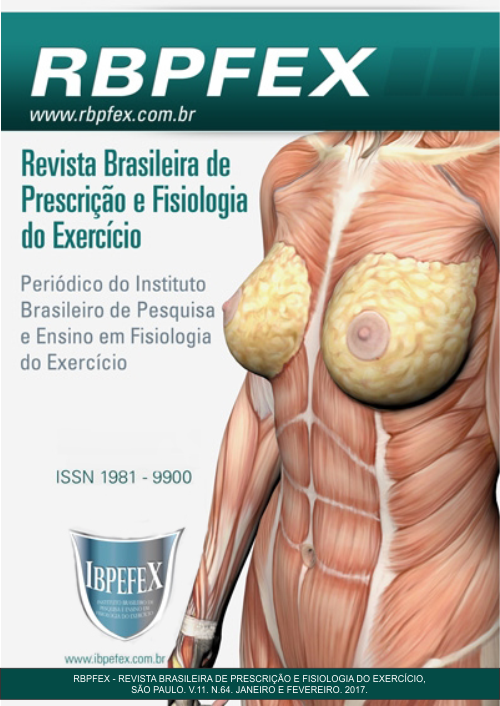Physical fitness level for sports performance of adolescents participants of the Sport in Action Project
Abstract
Introduction: Physical fitness is an extremely important factor in the development of sports and can be modified depending on the level of physical activity. Objective: To assess physical fitness levels for sports performance of adolescents aged 11 to 16, participants of the Sport in Action project, the city of Ubá-MG. Methods: We studied 22 adolescents with a mean age of 14.18 + 1.44 years. The evaluation was made through the following series of tests: body mass index (BMI), throwing Medicine Ball, horizontal jump, square test, running 20 meters and run or walk 6 minutes. For the classification used the PROESP manual, and the comparison between groups (11-14 years and 15-16 years) was performed using the Student t test. Results: We observed differences in explosive force of arms and legs, with the 15-16 years group showing higher averages (p <0.05). Among the group of 11-14 years, 27.3% were classified as overweight and obesity of any frame, while the group of 15-16 years was not observed overweight, but 18.2% were obese. Regarding the speed test, explosive speed of the lower limbs and cardiorespiratory fitness, the results are good. By contrast, agility tests and explosive strength of upper limbs, showed a high percentage of poor results. Conclusion: physical fitness levels of adolescents need to be improved in relation to parameters agility and explosive power of the upper limbs.
References
-Armstrong, N. Aptidão aeróbica de crianças e adolescentes. Jornal de Pediatria. Vol. 82. Num. 6. 2006. p. 406-408.
-Bhome, M. T. S. Relações entre aptidão física, esporte e treinamento esportivo. Revista brasileira de Ciência e Movimento. Vol. 11. Num. 3. 2003. p. 97-104.
-Braz, G.P.; RÉ, A.H.N. Relação entre aptidão física, envolvimento com bolae desempenho técnico de adolescentes no futsal. Revista Brasileira de Ciência e Movimento. Vol. 21. Num. 1. 2013. p. 151-157.
Conde, W. L.; Monteiro, C. A. Body mass índex cutoff points for evaluation of nutritional status in Brazilian children and adolescents. Jornal de Pediatria. Vol. 82. 2006. p. 266-271.
-Gallahue, D. L.; Ozmun, J. C. Compreendendo o desenvolvimento motor: bebês, crianças, adolescentes e adultos. 2ª edição. Phorte. 2003.
-Guedes, D. P.; Guedes, J. E. R. P. Atividade física, aptidão física e saúde. Revista Brasileira de Atividade Física e Saúde. Vol. 1. Num. 1. 1995. p. 18-35.
-Lughetti, C. N.; Ré, A. H. N.; Bohme, M. T. S. Indicadores de aptidão física de escolares da região centro-oeste da cidade de São Paulo. Revista Brasileira de Cineantopometria e Desempenho Humano. Vol. 12. Num. 5. 2010. p. 331-337.
-Machado, Y. L. Sedentarismo e suas consequências em crianças e adolescentes: trabalho de conclusão de curso. Muzambinho: IFSULDEMINAS. Trabalho de Conclusão de Curso Bacharelado em Educação Física. Instituto Federal de Educação Ciência e Tecnologia Sul de Minas. Muzambinho. 2011.
-Marques, M. C.; Travassos, B.; Almeida, R. A força explosiva, velocidade e capacidades motoras especificas em futebolistas juniores amadores: um estudo correlacional. Revista Motricidade. Vol. 6. Num. 3, 2010. p. 5-12.
-Matsudo, S. M. M.; Araujo, T. L.;Matsudo, V. K. R.; Andrade, D. R.; Valquer, W. Nível de atividade física em crianças e adolescentes de diferentes regiões de desenvolvimento. Revista Brasileira de Atividade Física e Saúde. Vol. 3. Num. 4, 1998, p. 14-26.
-Nieman, D.C. Exercício e Saúde. São Paulo. Manole. 1999.
-Paludo, A. C.; Batista, M. B.; Junior, H. S.; Cyrino, E. S.; Ronque, E. R. V. Aptidão cardiorrespiratória em adolescentes estimada pelo teste de corrida e/ou caminhada de 9 minutos. Revista Brasileira de Cineantropometria e Desempenho Humano. Vol. 14. Num. 4. 2012. p. 401-408.
-Pereira, C.H.; Ferreira, D. S.; Capetti, G. L.; Guimarães, L. C.; Barbacena, M. M.; Liggeri, N.; Castro, O. G.; Lobato, S.; David, A. C. Aptidão física em escolares de uma unidade de ensino de rede publica de Brasília-DF. Revista Brasileira de Atividade Física e Saúde. Vol. 16. Num. 3. 2011. p. 223-227.
-Pinho, R. A.; Petroski, E. L. Nível de atividade física em crianças. Revista Brasileira de Atividade Física e Saúde. Vol. 2. Num. 3. 1997. p. 67-79.
-Projeto Esporte Brasil (Proesp). Manual de testes e avaliação. 2015. Disponível em: <https://www.proesp.ufrgs.br/como-aplicar-o-PROESP.php>. Acesso em: 12/05/2015.
-Seabra, A.; Maia, J. A.; Garganta, R. Crescimento, maturação, aptidão física, força explosiva e habilidades motoras específicas: Estudo em jovens futebolistas e não futebolistas do sexo masculino dos 12 aos 16 anos de idade. Revista Portuguesa de Ciências do Desporto. Vol. 1. Num. 2. 2001. p. 22-35.
-Shepard, R.J. PAR-Q, Canadian home fitness test and exercise screening alternatives. Sports Medicine. Vol. 5. 1998. p. 185-195.
-Sociedade Brasileira de Pediatria. Atividade física na infância e na adolescência: guia prático para o pediatra. 2008. Disponível em: <http://www.sbp.com.br/src /uploads/2015/02/9667d-DOC-CIENT-AtivFisica.pdf>. Acesso em: 27/04/2015.
-Souza, V.; Batista, M. B.; Cyrino, E. S.; Blasquez, G.; Junior, H. S.; Pomanzini, M.; Silva, M. J. C. C.; Ronque, C. R. V. Associação entre aptidão cardiorrespiratória e participação regular de adolescentes em esportes. Revista Brasileira de Atividade Física e Saúde. Vol. 18. Num. 4. 2013. p. 511-512.
-Unicef. Fase inicial e fase final da adolescência. 2011. Disponível em: http://www.unicef.org/brazil/sowc2011/foco1.html. Acesso em: 02/10/2015.
Authors who publish in this journal agree to the following terms:
- Authors retain the copyright and grant the journal the right of first publication, with work simultaneously licensed under the Creative Commons Attribution License BY-NC which allows the sharing of the work with acknowledgment of the authorship of the work and initial publication in this journal.
- Authors are authorized to enter into additional contracts separately for non-exclusive distribution of the version of the work published in this journal (eg, publishing in institutional repository or book chapter), with acknowledgment of authorship and initial publication in this journal.
- Authors are allowed and encouraged to post and distribute their work online (eg, in institutional repositories or on their personal page) at any point before or during the editorial process, as this can bring about productive change as well as increase impact and impact. citation of published work (See The Effect of Free Access).






